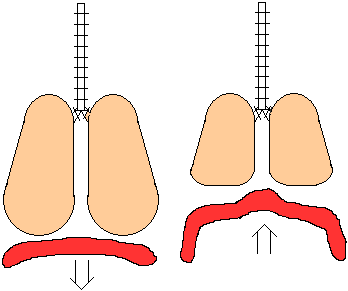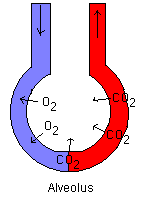1. Oxygen entering the body
2. Oxygen uptake in the lungs
3. What does the heart look like inside?
4. Systemic circulation and pulmonary circulation
5. Why does the heart have two atria and two ventricles?
6. Blood circulation - arteries, veins, capillaries
7. Cellular respiration reaction
8. Questions
Oxygen entering the body

Inhaled air contains oxygen that enters our lungs. We
breathe in air with 21 % oxygen and 0.03 % carbon dioxide.
We breathe out 16 % oxygen and 4 % carbon dioxide. Below the
lungs works a large muscle called the diaphragm. When the
muscle tenses (contracts), it pulls the lower part of the
chest cavity downward. The lower parts of the lungs are
pulled along as well. The chest cavity is enlarged and the
lungs as well. Air is flowing into the lungs. The diaphragm
is shown in red.
Left image: Inhalation. Active process - the muscle is
contracting.
Right image: Exhalation. Passive process – the muscle is
relaxing – is stretched.
Oxygen uptake in the
lungs

The trachea divides into two bronchi (air pipes). One
bronchus connects to each lung. The bronchus divides itself
and at the end of each branch is an alveolus. The
oxygen-poor (deoxygenated) blood from the heart (shown blue
- dark red in reality) absorbs oxygen from the air. This
makes the blood oxygen-rich (oxygenated: shown red - light
red in reality). Carbon dioxide from the blood enters the
alveolus cavity and is exhaled.
The oxygen migrates into the bloodstream from the alveoli
because the oxygen pressure is higher in the air and lower
in the blood. This pressure difference evens out
automatically the best it can. The same principle applies to
carbon dioxide, but the pressure difference is the opposite.
Small cells in the blood called red blood cells absorb the
oxygen. The red blood cells contain a protein called
hemoglobin. Hemoglobin makes the blood red. The oxygen-rich
blood is pumped further to the heart.
What does the heart look like inside?

The heart is a muscle that continually pumps blood through
blood vessels to all body parts. The heart pumps about 70
beats per minute. We say the pulse is 70.
The heart consists of two pumps that pump simultaneously.
One pump section consists of the right atrium and right
ventricle. The second pump section consists of the left
atrium and left ventricle.
There are valves between each atrium and ventricle but also
between the each ventricle and outgoing arteries e.g. the
aorta. When the ventricle muscles contract, the blood is
pumped out trough the artery. At the same time, the valve
between atrium and ventricle closes. These valves allow the
blood not to be pumped back into the atria, but only the
right direction. In the same way, when the heart is resting
between the beats, the blood that just was pumped out
through the artery, e.g. aorta, is trying to get back into
the ventricle. This is not possible, because of the valves
between the aorta and ventricle. These valves prevent blood
from flowing back into the ventricle. When the doctor is
listening to the heart with a stethoscope, the doctor is
hearing beating sounds, da-thump, thump-da, da-thump...etc.
It is the valves closing that sound. Try to see everything
in front of you.
Systemic circulation and pulmonary circulation
Systemic circulation: Oxygen-rich blood is sent out to the
body through the aorta, the body's largest artery, to
oxygenate e.g. the brain, liver, kidneys, muscles, i.e. all
bodily organs and tissues needing oxygen. After the oxygen
is consumed, it pours back to the heart finally through the
vena cava.
Pulmonary circulation: Oxygenation of the blood. The blood
flows to the lungs and back. The oxygen-poor blood is sent
from the heart out through the pulmonary arteries. As the
blood is oxygenated in the lung alveoli it flows back to the
heart through the pulmonary veins. The pulmonary arteries
are the only arteries transporting oxygen-poor blood while
the pulmonary veins are the only veins carrying oxygen-rich
blood. The blue color of the heart shows that the blood is
oxygen-poor (blue in the picture - dark red in reality).
Oxygen-rich blood is red in the picture – light red in
reality.
Why does the heart have two
atria and two ventricles?
To oxygenate the blood but also to rid the blood of carbon
dioxide two circulatory systems are created. Oxygenated and
deoxygenated bloods are not to be mixed. Therefore, a
muscular wall in the heart separates the systemic and
pulmonary circulations from each other. The white in the
picture above is the actual heart muscle. A muscle can only
contract. If you study the heart above you'll see what
happens when the heart muscle is contracting. The blood is
squeezed out.
Blood circulation - arteries, veins,
capillaries
Arteries: Blood vessels leading out from the heart. This
blood is oxygen-rich if it originates from the aorta and
oxygen-poor if it originates from the pulmonary arteries.
Veins: Blood vessels leading blood back to the heart. This
blood is oxygen-poor if it comes from the systemic
circulation and oxygen-rich if it comes from the pulmonary
circulation.
Eg. The blood flows out from the heart to body cells
through blood vessels called arteries and back to the heart
through blood vessels called veins.
Capillary: The blood has to pass between artery and vein.
These very thin blood vessels are called capillaries. If
stung in the finger, blood can emerge. This blood comes from
capillaries. The red blood cells deliver their oxygen in the
capillaries. The oxygen travels through the capillary wall
and out to the body cells that are oxygenated. Similarly,
the carbon dioxide leaves the cells and goes out to the
capillaries and entering the red blood cells. The blood is
now transporting carbon dioxide back to the heart. All
capillaries on the way back to the heart join with more
capillaries and these merged blood vessels end up wider.
These large collecting blood vessels are called veins.
Cellular respiration reaction
The now oxygenated cells use the oxygen to produce energy.
The energy enables the cells to work with their tasks, but
also to maintain a body temperature of approx. 37 oC. The
energy generating reaction is called the cellular
respiration reaction. Carbon dioxide and some water are
exhaled. This reaction occurs in the body cells.
oxygen + sugar  carbon dioxide + water + energy
carbon dioxide + water + energy
Questions
1.
How does oxygen enter into the body?
2.
What is the oxygen used for?
3.
When the body has used the oxygen, what does it give in turn
to the blood?
4.
What is an artery, vein and capillary?
5.
How does oxygen travel with the blood?
6.
Why is the blood red?
7.
How much oxygen does inhaled air contain?
8.
How much oxygen does exhaled air contain?
9.
How much carbon dioxide does inhaled air contain?
10.
How much carbon dioxide does exhaled air contain?
11.
What is the large muscle called that allows us to breathe
in? How does it work - explain for yourself?
12.
What gas exchange occurs in the lungs? Why does it happen?
13.
What is the pulse?
14.
What is the difference between ventricle and atrium?
15.
What is artery and what is vein?
16.
What is capillary?
17.
How is it possible for the doctor to listen to the heart?
18.
What is the main task of the systemic circulation?
19.
What is the main task of the pulmonary circulation?
20.
A muscle has only one task - which one?
21.
How can a muscle get energy?
22.
What is aorta?
23.
What is vena cava?
24.
What is the task of the valves? Describe where and why?
25.
Explain the cellular respiration reaction?
26.
Extra, search the Internet: How does sugar (glucose) find
its way to the cellular respiration reaction?
Copywrite NGU, Northern Pontifical Academy 2025 (A.I.C.)